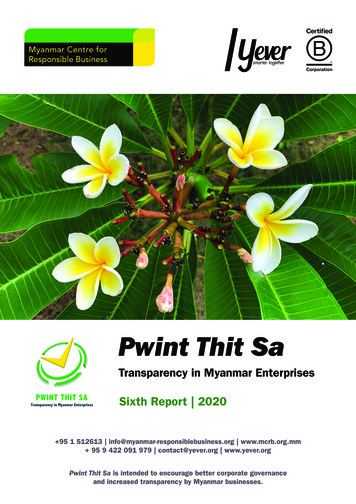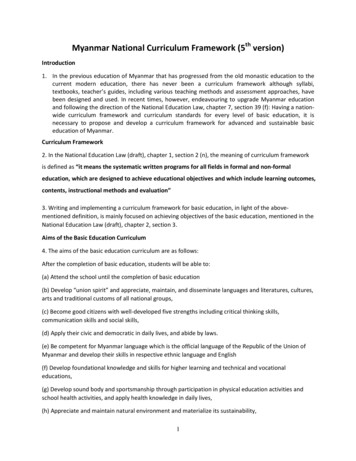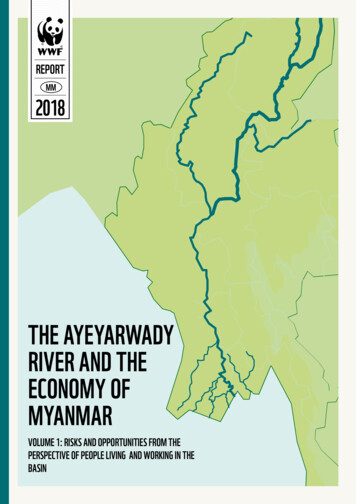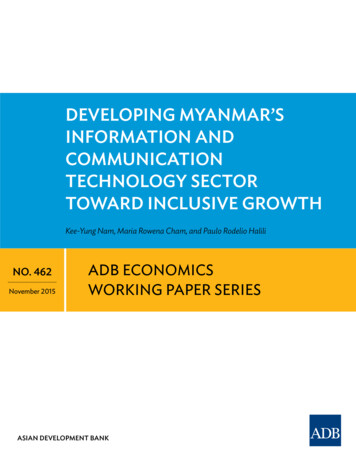
Transcription
DevelopInG MyAnMAr’SInforMATIon AnDCoMMunICATIonTeChnoloGy SeCTorTowArD InCluSIve GrowThKee-Yung Nam, Maria Rowena Cham, and Paulo Rodelio Halilino. 462november 2015adb economicsworking paper seriesASIAN DEVELOPMENT BANK
ADB Economics Working Paper SeriesDeveloping Myanmar’s Information and CommunicationTechnology Sector toward Inclusive GrowthKee-Yung Nam, Maria Rowena Cham,and Paulo Rodelio HaliliNo. 462 November 2015Kee-Yung Nam (kynam@adb.org) is PrincipalEconomist, Maria Rowena Cham (rmcham@adb.org) isSenior Economics Officer, and Paulo Rodelio Halili(phalili@adb.org) is Senior Economics Officer at theEconomic Research and Regional CooperationDepartment, Asian Development Bank (ADB).This paper was written as a background paper for theADB Myanmar Country Diagnostics Study. The authorswish to thank Ron Ico and Lotis Quiao for their excellentresearch support.ASIAN DEVELOPMENT BANK
Asian Development Bank6 ADB Avenue, Mandaluyong City1550 Metro Manila, Philippineswww.adb.org 2015 by Asian Development BankNovember 2015ISSN 2313-6537 (Print), 2313-6545 (e-ISSN)Publication Stock No. WPS157751-2The views expressed in this paper are those of the authors and do not necessarily reflect the views and policies of the AsianDevelopment Bank (ADB) or its Board of Governors or the governments they represent.ADB does not guarantee the accuracy of the data included in this publication and accepts no responsibility for anyconsequence of their use.By making any designation of or reference to a particular territory or geographic area, or by using the term “country” in thisdocument, ADB does not intend to make any judgments as to the legal or other status of any territory or area.Notes:1. In this publication, “ ” refers to US dollars.2. ADB recognizes “Korea” as the Republic of Korea and “Burma” as Myanmar.The ADB Economics Working Paper Series is a forum for stimulating discussion and eliciting feedbackon ongoing and recently completed research and policy studies undertaken by the Asian DevelopmentBank (ADB) staff, consultants, or resource persons. The series deals with key economic anddevelopment problems, particularly those facing the Asia and Pacific region; as well as conceptual,analytical, or methodological issues relating to project/program economic analysis, and statistical dataand measurement. The series aims to enhance the knowledge on Asia’s development and policychallenges; strengthen analytical rigor and quality of ADB’s country partnership strategies, and itssubregional and country operations; and improve the quality and availability of statistical data anddevelopment indicators for monitoring development effectiveness.The ADB Economics Working Paper Series is a quick-disseminating, informal publication whose titlescould subsequently be revised for publication as articles in professional journals or chapters in books.The series is maintained by the Economic Research and Regional Cooperation Department.
CONTENTSTABLES AND FIGURESvABSTRACTviI.INTRODUCTION1II.POLICY FRAMEWORK AT THE REGIONAL AND NATIONAL LEVELS2III.LEGAL AND REGULATORY FRAMEWORK4IV.REGULATORY POLICY BY SPECIFIC AREA6A.B.C.D.E.F.G.Competitive MarketsOwnershipLicensingSpectrum ManagementInfrastructure Sharing and InterconnectionVoice over Internet ProtocolUniversal Access and Service678891010V.INSTITUTIONAL FRAMEWORK11VI.CURRENT STATE OF INFORMATION AND COMMUNICATION TECHNOLOGY12A.B.1217VII.BEYOND INFORMATION AND COMMUNICATION TECHNOLOGYINFRASTRUCTURE: HUMAN DEVELOPMENT, INDUSTRIES, E-GOVERNANCEA.B.C.VIII.AccessibilityAffordability and Price ControlsHuman DevelopmentInformation and Communication Technology IndustriesInformation and Communication Technology as an Enabler in Public Services:e-Governance18182020INFORMATION AND COMMUNICATION TECHNOLOGY SECTOR CONSTRAINTS21A.B.22C.D.E.Absence of a Separate and Independent RegulatorInadequate Information and Communication Technology Legal Framework andImplementing GuidelinesLimited Foreign InvestmentInadequate Physical Infrastructure to Support Information and CommunicationTechnology InvestmentsSkills Gap and Mismatch in Information and Communication Technology22222323
IX.RECOMMENDATIONS23APPENDIX31REFERENCES41
TABLES AND FIGURESTABLES123456Level of Competition in Southeast Asia’s ICT Sector, 2014Foreign Ownership in ICT Sector in Southeast AsiaTechnical Summary of Myanmar ICT InfrastructurePenetration and Usage Rates of ICT ServicesQuality of Internet ServicePercentage of Population with Access to ICT Services7813131617FIGURES123Organization Structure of the MCITInvestment in Telecommunications ServicesIndicators of Computer Education in Higher EducationInstitutes in Myanmar, 1995–2011111619
ABSTRACTMyanmar’s recent socioeconomic and political reforms have signaled a readiness to reintegrate intothe world economy. To leapfrog the economy and accelerate growth, the country should takeadvantage of digital technology. This paper assesses Myanmar’s information and communicationtechnology sector, identifies constraints the sector faces, and recommends policies that will help thegovernment overcome them. Given limited public resources, Myanmar will need help translating itsinformation and communication technology infrastructure needs into financially viable and bankableprojects that can attract private sector financing.Keywords: e-governance, ICT infrastructure, information and communication technologydevelopment, Myanmar, telecommunicationsJEL Classification: L86, L88, L96, L98
I.INTRODUCTIONInformation and communication technology (ICT) infrastructure has been developing steadily incountries around the world. Yet, despite generally wide ICT coverage in major cities, levels in ruralareas is far from satisfactory; indeed, many people there still have no ICT access. Differences inincome, population size, and geography have created a digital divide between urban and rural areas,especially in Asia’s developing economies. At the regional level, one would think that a sizablepopulation anywhere in Asia would have access to mobile connections or fixed telephone lines. Butthe numbers paint a completely different picture, with large subregional and subnational disparities.For many decades, fixed lines delivered telecommunication services, which are reliable andfairly easy to expand. They are, however, expensive and require more time to install. Installation offixed lines has expanded mostly in major cities and highly populated areas, with high installation costsand geographical barriers in rural areas inhibiting installation and complicating maintenance of physicalinfrastructure such as cables.Wireless technology has provided alternative telecommunications access to rural and remoteareas. It can cover a wide range of areas without using cables and its equipment is relatively easy toinstall. The increased use of wireless technology is helping to expand access to ICT in the rural areas ofdeveloping economies, especially when basic infrastructure such as a trunk connection is already inplace. Although ICT coverage in rural areas in these economies has expanded significantly, poorcommercial viability has hindered expansion in sparsely populated and remote areas. New andemerging technologies can broaden coverage and penetrate any area. But the digital divide will not becompletely addressed as long as governments fail to overcome the various socioeconomic constraintsthat prohibit wider access to ICT services.Myanmar has signaled its readiness to reintegrate with the world economy through recentsocioeconomic and political reforms. These can enable Myanmar to achieve strong and sustainableeconomic growth and materially improve the lives of its people. Digital technology can enable thecountry to leapfrog the usual development track and further accelerate growth.For now, Myanmar’s internet, mobile, and telephone usage rates are Southeast Asia’s lowest.Its ICT infrastructure is inadequate and the industry is still in its infancy. But there is huge potential forICT development. And despite high upfront costs, the gains, in the form of higher productivity andmore efficient delivery of public and private commercial services, could be considerable.This paper assesses Myanmar’s ICT sector, identifies the constraints, and offers policy optionsfor the government to address them. In the rest of the paper, section II discusses the ICT policyframework at regional and national levels. Sections III and IV examine the legal and regulatoryframework governing the ICT sector, particularly on competitive markets, ownership, licensing,spectrum management, infrastructure sharing and interconnection, internet surveillance, and universalaccess. Sections V and VI outline the institutional framework and accessibility and affordability of ICTin Myanmar. Section VII discusses the sector’s human capital needs, the development of ICT-basedbusinesses, and the state of e-governance in Myanmar. Section VIII summarizes the main findings onthe constraints and section IX offers policy recommendations for the short- to medium-term toenable Myanmar’s ICT sector to catch up with its Southeast Asian neighbors.
2 ADB Economics Working Paper Series No. 462II.POLICY FRAMEWORK AT THE REGIONAL AND NATIONAL LEVELSMember countries of the Association of Southeast Asian Nations (ASEAN) are striving to become asingle community by 2015, and ICT development is viewed as an important factor to facilitateintegration, not only within member countries, but also within the region.Spearheaded by the ASEAN Telecommunications and Information Technology Ministers, anASEAN ICT Master Plan 2015 was formulated to harness ICT potential in establishing the ASEANEconomic Community. The master plan is a broad policy framework to guide ASEAN member states’ICT development over the next 5 years. The key outcomes of the master plan are to (i) develop ICT asan engine of growth for ASEAN countries, (ii) gain recognition for ASEAN as a global ICT hub, (iii)enhance the quality of life for the peoples of ASEAN, and (iv) contribute toward ASEAN integration.To achieve these key objectives, the plan formulates three foundations supporting three pillars. Thefoundations are infrastructure development, human capital development, and bridging the digitaldivide. The pillars are economic transformation, people empowerment and engagement, andinnovation.The development of Myanmar’s ICT sector will certainly bring advantages, as increased accessto information and communication will support the country’s economic transformation after decadesof military rule and international isolation. Studies show that investments in ICT, by improvingproductivity and connectivity, can spur growth. Investors are eyeing Myanmar opportunities as one ofthe last untapped markets in Asia, and its ICT sector has the potential to grow significantly afterdecades of underdevelopment.Despite the country’s growing population and market, however, the penetration rate of ICTservices is the lowest in Southeast Asia. Mobile cellular subscribers were only 49.47 per 100 people in2014, despite increasing some 50-fold in the 6 years before that. This is far below mobile penetrationrates per 100 people of Cambodia (155), Thailand (144), and Viet Nam (147) in 2014. And althoughfixed telephone subscriptions have increased by a factor of two since 1995, they are still only 0.98subscription per 100 people, with an estimated base of 0.5 million subscribers. The internet userpenetration rate is similarly low, at just over 1%, according to 2013 data from the InternationalTelecommunication Union (ITU).Telecommunications services remain financially out of reach for the average Myanmar citizen.Call rates, for one thing, are high at an estimated 0.30 per minute. And telecommunication-relatedinfrastructure, as noted, has mostly favored urban areas.The government has laid down the policy framework for developing the telecommunicationsand ICT industry by introducing competition for foreign and domestic operators. This is in line with itsobjective to foster overall economic development. The main objectives of the policy is increasing thecountry’s mobile teledensity to 80% by FY2015 and making telecommunication services available tothe general public at affordable prices, especially in rural areas.1 Moreover, the government aims toallow citizens and private businesses to choose the telecommunication service that best suits theirneeds. This ambitious plan, which is needed if the country is to integrate into the global economy, willrequire billions of dollars in investments to improve network infrastructure and increase access,especially of the rural population.1FY refers to the fiscal year, which is from 1 April to 31 March in Myanmar. FY before a calendar year denotes the year inwhich the fiscal year starts, that is, FY2015 begins on 1 April 2015 and ends on 31 March 2016.
Developing Myanmar’s Information and Communication Technology Sector toward Inclusive Growth 3As well as the need to build and update its ICT infrastructure, Myanmar needs to update, draft,and, in some cases, repeal laws governing the sector (in particular telecommunications and internetdevelopment and usage). It needs to set up a regulatory framework for the sector to ease investoruncertainty; indeed, the potential for ICT growth will be constrained if there is no clarity in regulationsand the various processes for private sector participation.Myanmar’s telecommunication laws have been undergoing such changes to address these andother emerging issues the sector faces. The Ministry of Communications and Information Technology(MCIT) oversees the sector, but this institutional arrangement needs to be reviewed to ensure that itsfunctions align with the sector’s needs. More groundwork is needed for financing and implementing anetwork expansion and additional infrastructure requirements. If the government can adopt a stableregulatory framework, in addition to the various structural reforms it has been implementing, thenMyanmar should be able to attract foreign investment to the ICT sector. This in turn can help thegovernment achieve its growth and inclusiveness objectives for the economy.Myanmar recognizes that ICT is a key enabler and a priority for socioeconomic development.The Framework for Economic and Social Reform, formulated in 2013, sets out policy priorities until2016, and includes the development of mobile telephony and internet. The framework highlights thefollowing ICT-related reform objectives:(i)(ii)achieving 80% penetration services by 2015;allowing for full sector liberalization by opening the ICT market to both foreign anddomestic investors on a nondiscriminatory basis, implementing a regulatory system thatcan ensure effective competition among suppliers, and regulating tariffs;(iii) upgrading internet infrastructure to allow a comprehensive e-strategy for leapfrogging in,among other areas, education programs, government regulation, and knowledgemanagement; and(iv) increasing the technical competence of the workforce through training on marketoriented technical and language skills.The government has also identified the need to update its own ICT Master Plan tooperationalize the reforms identified under the Framework for Economic and Social Reform. Thedevelopment of an e-government national portal is ongoing, as is the creation of the bodies that willimplement e-government plans. In 2013, a new Telecommunications Law was approved that aims todelineate the policy, regulatory, and operational functions of various stakeholders in the sector. Otherrelated laws to support the development of the ICT sector are also being pursued as part of thecountry’s ASEAN Economic Community commitments. These laws, once passed, will make Myanmarthe fourth ASEAN nation to have ICT laws (Ministry of Communications, Posts, and Telegraphs, KoreaInternational Cooperation Agency, and Electric and Telecommunications Research Institute 2011).There have already been three previous ICT master plans: the 2000–2005 ICT Master Plan,the 2006–2010 ICT Master Plan and Action Plan, and the 2011–2015 Follow Up Plan. The first focusedon expediting the implementation of ICT development plans and establishing physical infrastructure.This includes the Yatanarpon Cyber City opened in 2007, the country’s largest IT center, MyanmarICT Park, and Bagan International Data Communication Center and Teleport, both opened in 2001(ITU 2012a). The 2006–2010 plan laid the foundations to achieve the goal of increasing theteledensity rate from 1% in 2005 to 5.4% by 2011. Despite these well-laid plans, the ICT sector has notdeveloped as expected. Sanctions, global recession, lack of prioritization in the ICT sector, sluggish firm
4 ADB Economics Working Paper Series No. 462performance, and heavy competition hamper the sector’s development (Ministry of Communications,Posts, and Telegraphs, Korea International Cooperation Agency, and Electric and TelecommunicationsResearch Institute 2011). The theme of the 2011–2015 Follow Up Plan (Ministry of Communications,Posts and Telegraphs, and Korea International Cooperation Agency 2011) was “socio-economicdevelopment through knowledge-based society.” Its main objectives were enhancing the ability ofcitizens to use ICT, strengthening national competitiveness by promoting informatization, facilitatingeconomic growth by promoting the ICT industry and establishing information infrastructure, andrealizing good governance and clean government through ICT.The plan has several focus areas including (i) building ICT infrastructure, ICT human resourcedevelopment, and a legal framework for ICT; (ii) industry promotion, which covers the development ofindustry standards, and facilitating the liberalization of the industry; and (iii) use of ICT in eeducation, e-commerce, e-government, informatization, and e-society. These focus areas weregrouped into five action plans—ICT infrastructure, ICT industry, ICT human resources development,e-education, and ICT legal framework. The action plans are to be implemented by various ministriesand departments over the next 10 years.The development of a broadband service has become an international focus of developmentpartners and agencies engaged in Myanmar, including the ITU and the United Nations Educational,Scientific and Cultural Organization. This resulted in the incorporation of broadband targets into theMillennium Development Goals and the creation of the Broadband Commission, a joint undertaking ofboth agencies. In Southeast Asia, along with Cambodia and the Lao People’s Democratic Republic(Lao PDR), Myanmar has yet to adopt a national broadband plan (Table A.1).2III.LEGAL AND REGULATORY FRAMEWORKThe government has begun updating its laws governing the telecommunications sector to include ICTrelated services. The main objective of the new Telecommunications Law, passed in October 2013, isto liberalize the market to allow for more private domestic and foreign operators and investors toprovide efficient ICT services. The law’s provisions expand the telecommunication networkthroughout the country and facilitate the sector’s development (ITU 2012a). It provides for theestablishment of the types of licenses, and the basic rules on interconnection, competition, anddispute resolution. The law sets out the authority and powers of the MCIT and, more importantly, itprovides for the creation of an independent regulator, the Myanmar Telecommunications Commissionby 2015 and the government’s overall policy on private sector participation in the sector. It alsocontains modern ICT elements, including a requirement for access and interconnection (andinfrastructure sharing), competition safeguards, and a licensing structure similar to other ASEANmarkets. The law was developed following a year of wide-ranging consultations with stakeholders.Under the new Telecommunications Law, the MCIT is mandated to establish mechanisms tofulfill universal service obligations, including establishing a universal service fund. Notifications andspecial orders are being promulgated to allow private domestic companies to providetelecommunications services (Smith 2012). In addition, the law also provides for transition2However, ITU selected Myanmar as one of the four countries in Asia and the Pacific (Nepal, Samoa, and Viet Nam werethe others) where the ITU itself developed a national pilot wireless broadband master plan for the country. The masterplan is titled Wireless Broadband Masterplan for the Union of Myanmar of ITU. The Government of Myanmar also hasbroad action items related to broadband deployment under the National Broadband Deployment CLMV/S10-3 Salai Samuel Win Tin.pdf).
Developing Myanmar’s Information and Communication Technology Sector toward Inclusive Growth 5arrangements wherein the existing Post and Telecommunications Department (PTD) under the MCITwill be in charge of regulatory functions, such as numbering and spectrum planning. The PTD, withWorld Bank assistance, among other things, will develop an operational sector road map, institute aprocess of formulating and adopting regulations, and develop and promulgate subsidiary legislations tocomplement the new Telecommunications Law and help the ICT industry move forward (ITU 2012a).These include regulations on licensing, competition, access, and spectrum and numbering that willenable the MCIT to address bottlenecks to fair competition and increased private participation in thesector.It is envisioned over the next few years that Myanmar’s ICT market structure will change fromthat of monopoly into a multioperator environment. Under this transformation, the PTD will transitioninto an independent telecommunications regulator, the Myanmar Telecommunications Commission.This will be established under a provision of the new Telecommunications Law. State-owned MyanmaPosts and Telecommunications (MPT) will be restructured into a commercial entity and, eventually,privatized. The MCIT will be responsible for making ICT sector policy and will be the main line ministrysupporting the implementation of e-government initiatives.As for an overall ICT regulatory framework, Myanmar is still adopting the necessary regulationsto implement the new Telecommunications Law. For example, it is revising the Electronic TransactionLaw to reflect good practice, which is largely modeled on the UN Model Law on Electronic Commerce(1996, as amended) and the UN Model Law on Electronic Signatures (2001). Three laws andregulations govern ICT development:(i)The Computer Science Development Law of 1986 defines and provides measures for thedevelopment and dissemination of computer science and technology, including thesupervision of imports and exports of computer software and information.(ii) The Wide Area Network Order of 2002 allows for the establishment of a computer webusing a wide area network; it focuses on prohibiting illegal acts relating to network usage.(iii) The Electronic Transactions Law of 2004 aims to build trust in e-commerce, egovernment, and online banking. But moves are under way to replace this law, because itonly covers a small part of a comprehensive informatization promotion plan (Orbicomand International Development Research Centre 2009), and it includes provisions thatcan infringe on citizens’ rights and privileges in relation to the free flow of informationand free speech.Myanmar still has no law or regulations on intellectual property rights, privacy, right toinformation, or legislation related to cybercrimes. While these are definitely issues government hasbeen made aware of, no definite plan or target has been set on when these will be drafted and thetiming of its approval and implementation.Other laws also have bearing or indirectly affect the development of the ICT sector (ITU2012a). These include the:(i)The State-owned Economic Enterprises Law of 1989 grants government the sole right tocarry out a range of economic enterprises as state-owned economic enterprises,including a postal and telecommunications service. But in accordance with Section 4 ofthe law, the state-owned enterprise acting on the country’s interest is permitted to enterinto joint ventures with any other person or economic entity, subject to conditions.
6 ADB Economics Working Paper Series No. 462(ii)The Myanmar Special Economic Zone Law of 2011, which provides for the establishmentof special economic zones, including information and telecommunication technologyzones (ITU 2012a).(iii) The Foreign Investment Law of 2013 allows for 100% foreign ownership of localbusinesses with approval from the Foreign Investment Commission in many areas ofinvestments, including ICT (Deloitte Southeast Asia 2012).In the regulatory environment, Myanmar is the only country in Southeast Asia without aseparate telecom or ICT regulator, one of the main building blocks of regulatory reform worldwide(Table A.2) (Ramamurthy 2013). Although the PTD is tasked as the telecoms and ICT “regulator,” it isnot an autonomous entity compared to regulators in other Southeast Asian countries, notably those inMalaysia, the Philippines, Singapore, and Thailand. Moreover, there is a perception of insufficienttransparency and public participation in the policies and laws that concern the citizenry in as much aspublic consultations are not mandatory before regulatory decisions are conducted.Given the nascent nature of the information technology (IT) industry, regulatory enforcementhas been primarily focused on ex ante regulation (for example, licensing, assigning spectrum and otherscarce resources, and dealing with interconnection issues) and general competitive issues (forexample, mergers and acquisitions, and dominance and significant market power in convergedtechnologies and services). Ex post regulations such as imposing remedies, sanctions, and penalties formarket abuse by operators with significant market power, handling consumer complaints, and otherissues such as copyright, privacy, cybercrime, and online content have yet to be established. Thecurrent processes in enforcement and dispute resolution are regarded as unfavorable to consumersand the general public because these do not benefit from public consultations. Regulatory decisionsare made unilaterally and do not permit consumer complaints, contrary to usual practice in othercountries (Table A.7).The dispersed assignments of regulatory functions to various ministries, departments, andcommittees in Myanmar are in stark contrast to the tight regulatory environment existing today inmost countries in Southeast Asia. In Myanmar, critical functions, which are usually assigned to theregulator, are scattered across different institutions. While the PTD is the supposed regulator,licensing, price regulation, radio frequency allocation and assignment, and spectrum monitoring andenforcement are under the MCIT. Some other regulatory functions including numbering, servicequality monitoring, broadcasting (radio and TV transmission), and IT are shared by the MCIT withoperators and other ministries. However, the following areas remain unregulated: interconnectionrates, technical standards setting, type approval, universal service and access, quality of servicestandards setting, enforcement of service obligations, broadcasting content, and internet content.IV.A.REGULATORY POLICY BY SPECIFIC AREACompetitive MarketsAs a monopoly, MPT is the sole provider of mobile and fixed telephony services. Currently, 14,000kilometers of fiber optics and around 1,800 towers connect Myanmar, 80% of this infrastructure isowned by the military, with the MPT owning the rest (Deloitte Southeast Asia 2012). Even though amonopoly, MPT has the option to grant distribution rights to trusted companies, and smaller firmsseeking vending rights must purchase equipment from these distributors (Freedom House 2012 and2013). Internet services, which were only introduced in Myanmar in 1999, are provided by just a few
Developing Myanmar’s Information and Communication Technology Sector toward Inclusive Growth 7providers: MPT, public company Yatanarpon Teleport, and privately owned Red LinkCommunications, SkyNet, and other Fiber To The Home providers. ICT services are still mainly underthe control of the government. Although foreign companies such as Huawei and ZTE are now sellingtelecommunications-related equipment such as handsets and satellite equipment (Nomura EquityResearch 2012), no competition-related policy or regulation on handset distribution is in force.Myanmar is the only country in Southeast Asia with a monopolistic structure in most of its ICTservices (Table 1). In this regard, the new Telecommunications Law intends to address competitionand price setting issues. At present, tariff setting and approval is under the jurisdiction of the PTD. Thelaw provides that “a licensee shall submit the schedules of tariffs for the existing services or theservices to be introduced in respect of any telecommunications service business to the regulator; theregulator shall allow the proposed schedules of tariffs with the approval of the Ministry”(Vanderbruggen and Naing 2012).Table 1: Level of Competition in Southeast Asia’s ICT Sector, 2014BRUNCAMNINOCLAO.MALNMYAMPHICSINNDomestic fixedlong distanceLeased linesMCPPMCPCC.MCLocal fixed lineservicesMobileMCPPMCPCCPMCVery smallaperture 98)MCC(2000)C(2000)C(2000)C(2000)C(2000)Cable televisionTHAC(2012)C(2005)CVIECCCPCPCCC not applicable, BRU Brunei Darussalam, C full competition, CAM Cambodia, ICT information and communication technology,INO Indonesia, LAO Lao People’s Democratic Republic, M monopoly, MAL Malaysia, MYA Myanmar, N not available, P partialcompetition, PHI Philippines, SIN Singapore, THA Thailand, VIE Viet Nam.Source: International Telecommunication Union, World
Given limited public resources, Myanmar will need help translating its information and communication technology infrastructure needs into financially viable and bankable projects that can attract private sector financing. Keywords: e-governance, ICT infrastructure, information and communication technology development, Myanmar, telecommunications
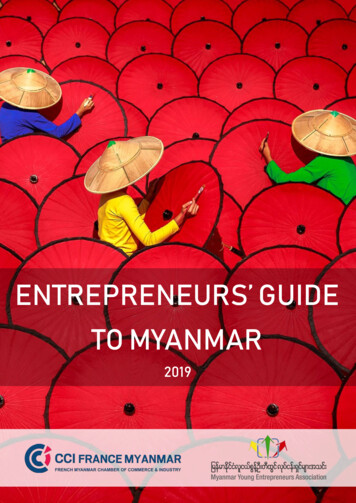
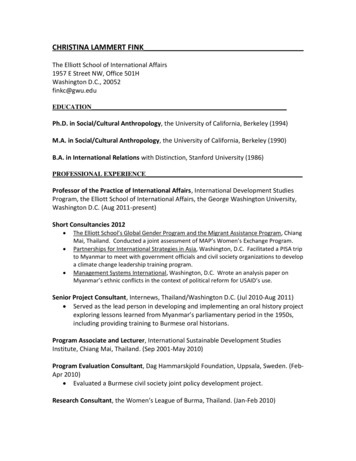
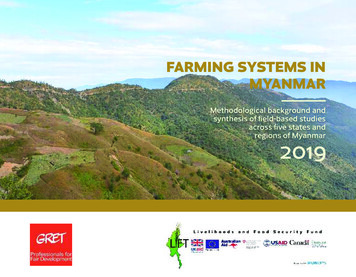

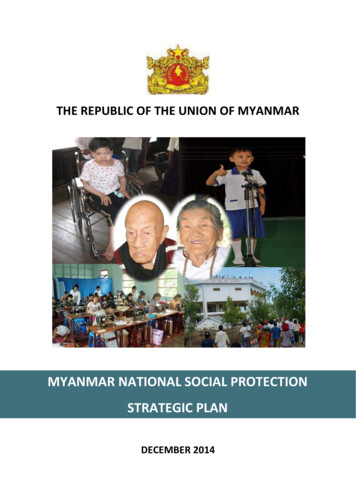
![Myanmar 2015-16 Demographic and Health Survey - Key Findings [SR235]](/img/66/sr235.jpg)
